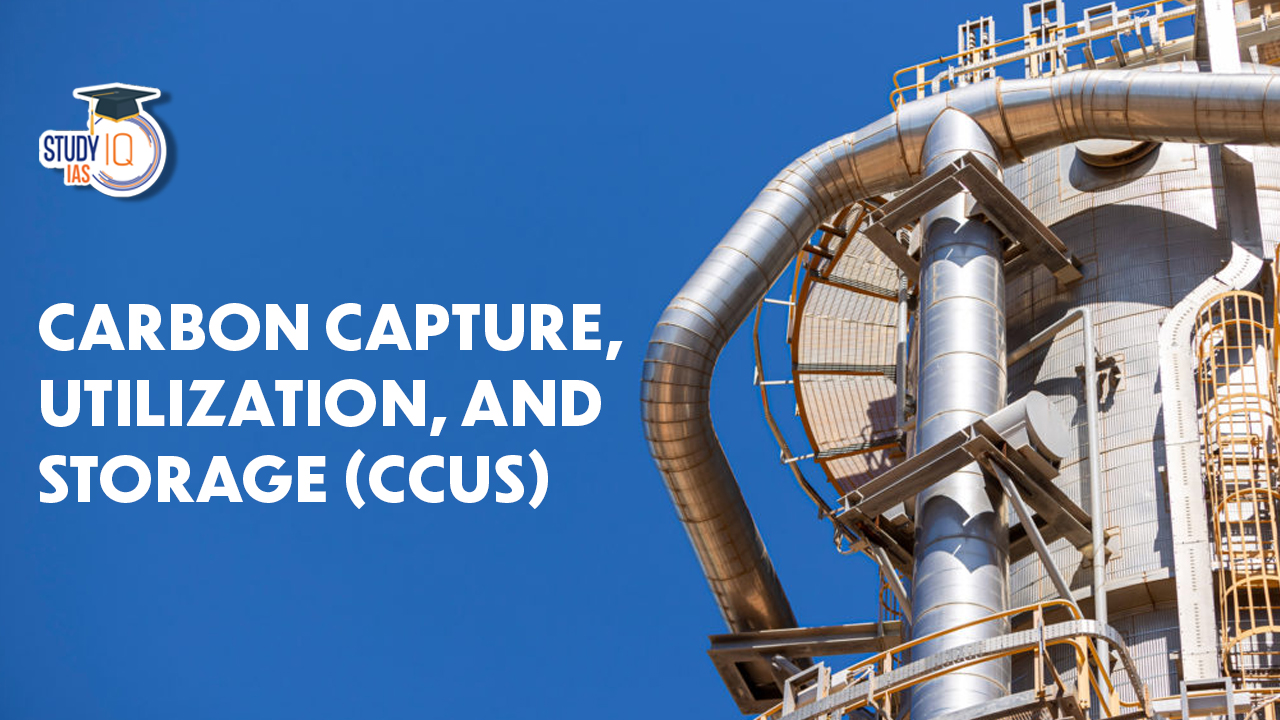Table of Contents
Context: The appointment of Sultan al-Jaber, the CEO of Abu Dhabi National Oil Company (ADNOC) and the UAE’s Minister of Industry and Advanced Technology, as the President of COP28, has faced criticism for several reasons.
More on the News
His appointment has faced criticism due to the following reasons:
- Firstly, there is concern over the conflict of interest inherent in appointing an oil executive to lead climate negotiations. Critics argue that an oil executive may not prioritize the necessary reduction of fossil fuel production and consumption, which is crucial for meeting the goals of the Paris Agreement.
- Secondly, experts and other nations oppose al-Jaber’s advocacy of carbon capture, utilization, and storage (CCUS) technologies as a solution to climate change. They argue that such technologies have not been tested at scale and may divert attention and resources from more effective alternatives, such as renewable energy. Some stakeholders believe that CCUS should only be employed in sectors where emission reduction is extremely challenging.
- Opposition to al-Jaber’s presidency also stems from concerns about the influence of the fossil fuel industry in climate negotiations. Critics worry that al-Jaber’s appointment could further amplify the role of fossil fuel interests in shaping climate policies.
- Furthermore, some argue that having an oil executive as the COP28 President undermines the negotiations, as it may hinder progress toward the necessary reduction of carbon emissions. They emphasize the need for concrete action to phase out fossil fuels, in line with the goal of limiting global warming to 1.5°C above pre-industrial levels.
What is Carbon Capture Utilization and Storage (CCUS)?
- Carbon Capture, Utilization, and Storage (CCUS) encompasses methods and technologies to remove CO2 from the flue gas and from the atmosphere, followed by recycling the CO2 for utilization and determining safe and permanent storage options.
- CO2 captured using CCUS technologies is converted into fuel (methane and methanol), refrigerants and building materials.
- The captured gas is used directly in fire extinguishers, pharma, food and beverage industries as well as the agricultural sector.
- CCUS technologies can play an important role in meeting net zero targets, including as one of few solutions to tackle emissions from heavy industry and to remove carbon from the atmosphere.
- CCUS is considered an important tool to help countries halve their emissions by 2030 and reach net-zero by 2050.
- These goals are crucial to meet the Paris Agreement targets for restricting global warming to 2 degrees Celsius (°C), and preferable to 1.5°C, over pre-industrial levels.

Why is there a need for CCUS in India?
- Achieving Net-Zero: India has committed to reducing CO2 emissions by 50% by 2050 and reaching net zero by 2070. Though we are making great strides in decarbonizing the power sector, it only contributes to about 1/3rd of the total emissions. CCUS has a crucial role to play for the decarbonization of industrial sector which contributes another one third.
- Hard-to-abate sectors: CCUS offers the only known technology for the decarbonization of hard-to-electrify CO2 intensive sectors such as steel, cement, oil & gas, petrochemicals & chemicals, and fertilizers.
- Economic opportunities: Adoption of CCUS offers numerous economic benefits such as:
- Enabling sunrise sectors: CCUS is expected to play a major role in enabling sunrise sectors such as coal gasification and nascent hydrogen economy in India.
- Employment generation: The report estimates that about 750 mtpa carbon capture by 2050 can create employment opportunities of 8-10 million full time equivalent (FTE) basis.
- Circular economy: Carbon utilization technologies can provide a wide variety of opportunities to convert the captured CO2 to value-added products with a ready market in India, thus contributing to the circular economy.

| Green urea | Green urea can be produced from the captured CO2 and green hydrogen, from renewable energy based electrolysis of water. |
| F&B applications | Captured CO2 is utilized in F&B applications such as carbonated drinks, dry ice, and modified atmosphere packing. |
| Building materials | Captured CO2 can be utilized for producing building materials through concrete curing and aggregate formation. |
| Chemicals | Conversion of CO2 to methanol and ethanol from CO2 is proven at a commercial scale in different parts of the world. |
| Polymers | Conversion of CO2 to various polymers ((including bio-plastics) has been attempted globally at different scales, and presents another possible CO2 utilization route. |
| Enhanced Oil Recovery (EOR) | CO2 based EOR has been successfully operating for decades for producing low-carbon oil from maturing oil fields in North America and other geographies |
Various Carbon Capture Technologies for Different Applications: There are different types of commercial-scale carbon capture technologies based on the typical CO2 gas stream composition.
- Chemical solvent-based CO2 capture technologies: Preferred when dealing with gas streams that are lean in CO2 and have relatively lower pressures such as flue gas streams from power plants.
- Physical solvent-based CO2 capture technologies: These work well on gas streams with relatively higher CO2 concentration and pressure, such as gasification projects.
- Adsorption-based CO2 capture technologies: Suitable for gas streams with moderate to high pressure and moderate CO2 concentration such as SMR flue gas or BF gas (Blast furnace gas).
- Cryogenic CO2 capture technologies: Preferred in cases where the cost of power is low. This technology can be applied for carbon capture from the PSA tail gas of Steam Methane Reforming Units.
Current landscape of Carbon Capture, Utilization, and Storage (CCUS) technologies
| Global | India |
|
|
Potential for CO2 Storage in India
- For effective CCUS adoption at scale, apart from the conversion of CO2 to useful value-added products, there needs to be a clear strategy for permanent geological storage of CO2.
- The options for the geological storage of CO2 include EOR (Enhanced Oil Recovery), ECBMR (Enhanced Coal Bed Methane Recovery) and permanent storage options like saline aquifers and basalt storage.

The key elements of the recommended CCUS policy framework for India
- Policy path: CCUS policy in India should be carbon credits or incentives based and provide early stage financing and funding mechanisms for CCUS projects.
- Hub & cluster business model: The policy framework should promote the creation of regional hub & cluster models to drive economies of scale across the CCUS value chain, with defined roles for emitters, aggregators, hub operators, disposers and conversion agents.
- Low carbon products: Low carbon or carbon-abated products need to be supported through preferential procurement in Government tenders and Production Linked Incentive (PLI) schemes.
- Environmental and social justice: CCUS policy should protect communities most affected by environmental and climate change by ensuring the distribution of the economic value created by CCUS.
- Regulatory framework: To incentivize carbon capture in different sectors, there is a need to establish a baseline of regulated emission levels and allowances for different sectors.
- Risk mitigation: There is a need to de-risk CCUS projects by limiting the liability and ownership of CO2 across the CCUS value chain and monitoring risk through appropriate Monitoring, Verification and Accounting (MVA) frameworks.
Challenges associated with the Carbon Capture, Utilization, and Storage (CCUS)
- High cost: The use of this technology requires significant investments into its equipment, R&D, transport and storage infrastructure for captured CO2 etc.
- License to ramp up emissions: CCUS can be perceived in a wrong direction and be used by emission heavy industries to push for the regular use of CCUS while maintaining polluting projects, thus defeating the true purpose of CCUS.
- Environmental concerns: Leakage of CO2 from storage facilities can contaminate the soil and groundwater and there is potential for seismic activity caused by underground injection of CO2.
- Price of Green Products: The issue of “inadequate prices” for low carbon or green products is a major risk factor for industries to adopt for CO2 utilization technologies.
Way forward
- Technology transfer: While the development of indigenous technologies is certainly desirable, the immediate focus should be on the transfer, assimilation and adoption of proven technologies in the CCUS domain.
- Promoting R&D in novel CO2 utilization technologies: The Government of India should promote an ecosystem to foster R&D and innovation in CO2 utilization technologies as they are relatively less developed, compared to capture technologies.
- Private sector participation: Private sector participation is essential to promote the transfer and commercialization of existing CCUS technologies and push for the development of new and emerging technologies.


 Daily Quiz 18 April 2025
Daily Quiz 18 April 2025
 OSSC CGL Syllabus 2025 and Exam Pattern ...
OSSC CGL Syllabus 2025 and Exam Pattern ...
 AI and its Regulation in India, Limitati...
AI and its Regulation in India, Limitati...





















